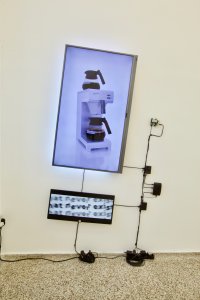Project Details
Coffee Lake is a video installation combining computer-generated video with animated text, created for the group exhibition "Machine sans nom" at Bonamatic. The installation takes its name from a widely distributed computer chip series—the same chips that were used to create the videos of the installation itself, creating a recursive loop between the technology of production and the subject matter.
The fragmented narrative of Coffee Lake takes place in the grey area between computer-simulated 3D graphics and human imagination. It operates in a zone where phenomena such as computer screens, lakes of coffee, simulated fire, and collective machines all influence our conceptions and expectations of the physical world. The work examines how digital processes shape our understanding of materiality and space.
Everything is normal
Everything is cool
Don't look at the power cables
Ignore the little black boxes on the wall
Don't look at the greasy fingerprints on the screen
Don't think about the people who made these objects
Don't think about the infallible computer chips inside
Don't listen to the noise of the ventilator.
Look at the screens
Look at the Bonamatic coffee maker
This ☕ does not exist
And yet it expresses something
Its structure tells us something
An unstable ☕ of liquid crystal light and colour
Pixels are to the coffee maker
As letters are to words
Pixels themselves have no meaning
They have meaning when put into use
Wherever pixels do not emit light
They become blurry mirrors
Reflecting situations in the world outside
instead of depicting an object that never existed
Imagine a ☕ growing inside of a ☕
A simulation of light rays hitting matter
A pixelated phantom image of a fictitious ☕
An acceptable computer simulation
Created by a chip named after an imaginary Coffee Lake
A miniature lake inside of a computer
Manufactured using an unstable process
Where half of the lakes produced are discarded
They are too hot and untrustworthy
Their calculations unexpected
Their language strange
[illegible letter fragments on large screen]
The human body is a factory
Driven by coffee to be productive
Just as this sequence of images
Provides the appearance of time and space
Coffee Lake vibrates impatiently
As reflection and simulation meet on the screen
They are no longer reasonable or separate
Electrical appliances hide a chaotic core
Reservoirs of strangeness buried inside of their functionality
Reservoirs of strangeness forgotten inside the everyday
Messy inner systems that that reimagine our world
chaotic systems that make images of imaginary objects
Echoing back to us distorted versions of what we know
Reflecting amended versions of the world we know
Promising that things do not have to remain as they are
The exhibition "Machine sans nom," named after one of Francis Picabia's machine paintings, examined the idea of the art object as a machine. The works were presented as productive machines possessing a capacity to carry out operations both as singular units and assembled into larger wholes. Instead of being representations in a conventional sense, they functioned as productions of effects, transforming the exhibition space into an operational field based on concepts such as energy, velocity, and transformation.
Coffee Lake continues Ørum's ongoing investigation of the analog and digital spaces we navigate daily, both physically and mentally. The machinic as a format for both production and display runs as a common thread through his practice. The work explores how computer technology mediates our relationship to the physical world, creating hybrid zones where digital simulation and material reality intersect.
The installation reflects on the pervasive presence of computational processes in contemporary life, using the specific example of the Coffee Lake processor to examine how the tools of digital production become embedded in the content they generate. The work suggests that our understanding of phenomena like fire, water, and collective action is increasingly shaped by computational models and digital representations.
By naming the work after the processor used to create it, Ørum draws attention to the material infrastructure of digital media while simultaneously questioning the boundaries between virtual and physical experience. The work operates as both a technical demonstration and a poetic meditation on the relationship between computation and imagination, revealing the "reservoirs of strangeness" that exist within everyday technological objects.

